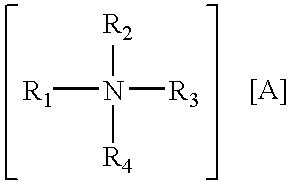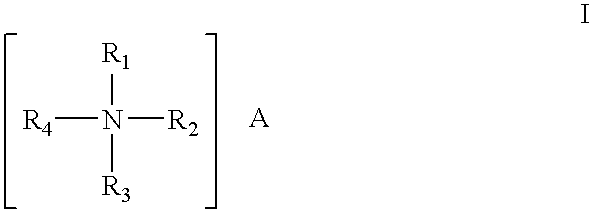Method for introducing antisense oligonucleotides into eucaryotic cells
a technology of eucaryotic cells and antisense oligonucleotides, which is applied in the direction of genetic material ingredients, drug compositions, oil/fat/waxes non-active ingredients, etc., to achieve the effect of efficient delivery of antisense oligonucleotides
- Summary
- Abstract
- Description
- Claims
- Application Information
AI Technical Summary
Benefits of technology
Problems solved by technology
Method used
Image
Examples
example 1
[0139] The cell lines HeLa, CHO-K1, CHO-S, 293F, K562, and HeLaS3 were transfected and assayed for a specific response to c-myc antisense oligonucleotides to investigate the potency of TR0 (a 1:2.5 w / w liposome formulation of the cationic lipid dimethyl dioctadecylammonium bromide (DDAB) and dioleyl phosphatidylethanolamine (DOPE)) as a non-toxic and specific means of delivery for antisense oligonucleotides. TR0 is sold under the trademark LIPOFECTACE™.
Transfection Procedure
[0140] The day before transfection, cells were plated in 96-well plates at an optimal seeding density according to each cell line described above. No antibiotics were used during these experiments. 200 nM of oligonucleotide (concentration calculated for a final volume of 100 μl) was added into 16 μl OPTI-MEM 1 Reduced Serum Medium. In a second tube, TR0 was diluted 1:5 in OPTI-MEM 1 Reduced Serum Medium and was incubated for 5-10 minutes at room temperature. Diluted TR0 was then added to diluted oligonucleotid...
example 2
[0144] HeLa cell line was transfected and assayed for a specific response to c-myc antisense oligonucleotides using the following transfection reagents:
[0145] TR1 (LIPOFECTIN™): LIPOFECTIN™ (a 1:1 w / w liposome formulation of the cationic lipid N-[1-(2,3-dioleyloxy)propyl]-N,N,N-trimethylammonium chloride (DOTMA) and dioleyl phosphatidylethanolamine (DOPE in membrane filtered water) was diluted in OPTI-MEM 1 and incubated for 30 minutes at room temperature prior to complexation. Final concentration of LIPOFECTIN™ added was 0.3 μl / mL.
[0146] TR2 (CellFECTIN™): The final concentration of CellFECTIN™ (a 1:1.5 M / M liposome formulation of a cationic lipid tetramethylpalmitylspermine (TMTPS) and DOPE) added per well was 0.2 μg / mL.
[0147] TR3 (DMRIE-C™): The final concentration of DMRIE-C™ (a 1:1 M / M liposome formulation of a cationic lipid N-(2-hydroxyethyl)-N,N-dimethyl-2,3-bis(tetradecyloxy)-1-propanaminium bromide (DMRIE) and cholesterol) added per well was 0.15 μg / mL.
[0148] TR4 (Lipo...
example 3
Western Blot Analysis
[0152] The ability of TR0 / ODN complexes to inhibit c-Raf protein expression was examined by western blot analysis. Transfections were performed in 6-well plates using HeLa cells plated at 60,000 cells / well. Cells were treated for 6 hours with 200 nM of c-raf antisense or mismatch oligonucleotide complexed to TR0 (undiluted reagent was added for a final amount of 3 μl / well). The same treatment was repeated after 24 hours according to the procedure described by Lau et al. (Oncogene 16:1899-1902 (1998)). Supernatant was transferred to a fresh microfuge tube.
[0153] For immunoblot analysis, cells were harvested at 24 hours and 48 hours and washed with 1× PBS without Ca++ or Mg++. Cellular extracts were prepared using 1 mL of boiling lysis buffer (1% SDS, 1.0 mM sodium orthovanadate (Sigma-Aldrich, St. Louis, Mos.), and 10 mM Tris-HCl, pH 7.4). Typically, about 400 ng of protein were then separated and by electrophoresis on a 4-12% NuPage® Bis-Tris SDS-polyacrylamid...
PUM
| Property | Measurement | Unit |
|---|---|---|
| concentration | aaaaa | aaaaa |
| diameter | aaaaa | aaaaa |
| diameter | aaaaa | aaaaa |
Abstract
Description
Claims
Application Information
 Login to View More
Login to View More - R&D
- Intellectual Property
- Life Sciences
- Materials
- Tech Scout
- Unparalleled Data Quality
- Higher Quality Content
- 60% Fewer Hallucinations
Browse by: Latest US Patents, China's latest patents, Technical Efficacy Thesaurus, Application Domain, Technology Topic, Popular Technical Reports.
© 2025 PatSnap. All rights reserved.Legal|Privacy policy|Modern Slavery Act Transparency Statement|Sitemap|About US| Contact US: help@patsnap.com



